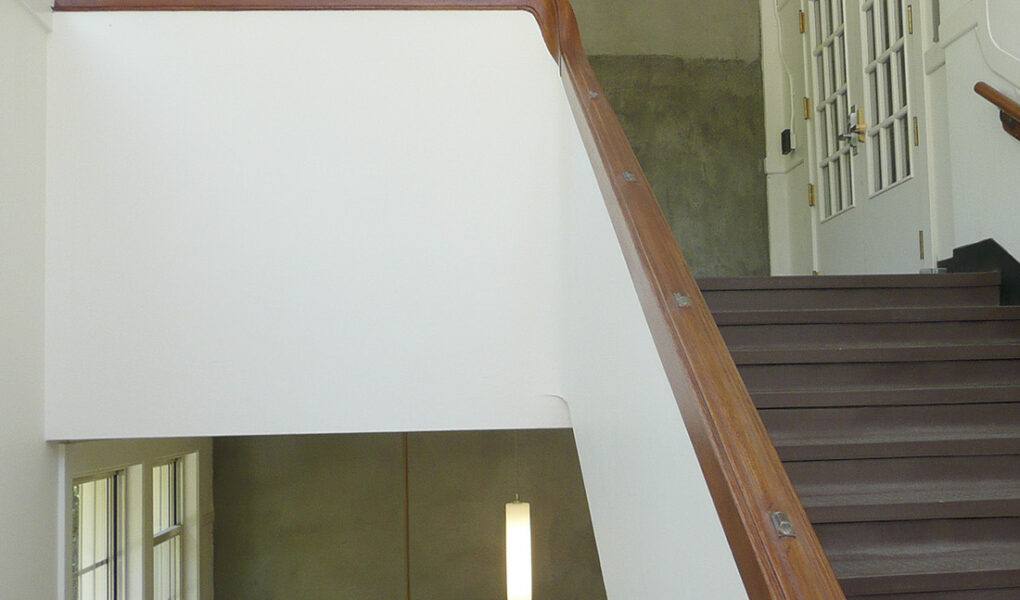Photo: Sean Healy and Joe Thurston: This is a Plumb Bob. Portland, Oregon: Portland State Univeristy and Oregon Arts Commission, 2010.
Originally published February, 2011
In the Halls of Shattuck
By Lisa Radon
When I locate Kari Merkl’s space age seating installation tucked into a short side hall on the second floor of Portland State University’s Shattuck Hall, two students have so thoroughly installed themselves with books, food, laptops plugged in, that you’d think they were going to live there. You too might want to live in this space with two super-modern wing-backed chairs-all curves and planes in cool walnut plywood with curved upholstered inserts in hot pink and charcoal felt. Facing one another across a long bench with a pink enameled metal channel, each of the chairs has its own built-in table, not unlike old-fashioned school desks, and access to electrical outlets. “I had been looking at different ways designers and architects have used public versus private space,” Merkl says. “The two end pieces, the wing-backed chairs represent the private while the bench between is more public.”
As part of a renovation by SRG Partnership of the home of PSU’s architecture program, a number of regional artists and furniture designers were commissioned in this Percent for Art project to create functional and site-specific projects. Most of the projects are artful seating solutions in the halls of the building.
“Initially, when I saw the space I was assigned, there was a pile of carpet scraps, mostly brown and grey, a couple orange and bright purple. And the color really popped out. It made me realize there wasn’t a lot of color on the floor.” She highlighted the metal channels that run along the backs of the bench and frame the outlets with a strong hot pink.
Nearby there is a flash of orange among the grouping of low rounded three corner Ube stools by Chris Bleiler and Jen Jako of fix studio. Appropriately in a building that houses an architecture program, the stools represent a kind of materials study with some formed from a single center cut of douglas fir, some upholstered in dark grey, and some in bright plastic. Jen Jako says of the Ube, “It’s an evolution of a form, from wood to upholstery to metal to rotomolded plastic.”
The steel of which a couple of the stools is a material that reappears throughout the building. In the Department of Architecture Reading Room, Matthew Bietz of Quartertwenty designed a long table around which small gatherings can convene. It evolves from steel with a glass insert at one end to a heavy blond wood slab with a natural edge at the other. The glass insert echoes the large steel and glass door to the space, and the table divides into two pieces, one steel and one primarily wood, for mobility. In the hall outside the Reading Room, the steel appears again in bench seating designed by George Suyama that appears to be suspended from metal poles giving lightness to heaviness. Down the hall, Brennan Conaway plays with weightiness in his imposing stone slab bench cradled on a steel slat support with a slat table at one end. Conaway’s bench both brings the outside in in a very direct way and echoes the concrete floors throughout the halls.
Downstairs, fittingly just outside a bank of windows overlooking the department’s woodshop, Brandon Flores created a pair of carved wood benches whose surfaces are carved with interlocking ridges and grooves whose form hints at the kind of topographical mapping that is the beginning of any architectural project.
Finally, in the NW stairwell, a gargantuan plumb bob “hangs” an inch off the floor from a carved wood “rope” that spans two floors. Artists Joe Thurston and Sean Healy created this overlarge version of the simple tool that performs a most essential function in building finding a true vertical reference line. Thurston talks about the complexity of casting the oversized plumb bob working with Barr Casting, a multi-generational family business in southeast Portland. Cast in from silicon bronze with a German silver tip, the plumb bob is designed to age with the building tarnishing as it responds to the touch of viewers.
Courtesy of The Oregon Arts Commission.
Artist Credit: Kari Merkl, Fix Studio, Matthew Bietz (Quartertwenty), George Suyama, Brennan Conaway, Brandon Flores, Joe Thurston and Sean Healy
Exhibition: Oregon Percent for Art in Public Places
